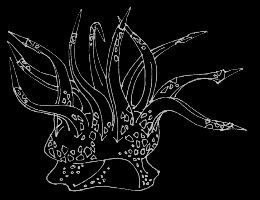 The Ly-cilph:
The Ly-cilph:
 The Ly-cilph:
The Ly-cilph:
Life on a moon (one of 29) orbiting a gas supergiant. Fourth out from star, only one with an atmosphere. Perpetual tropical climate on the nearside, moving via storms to the farside where it cools. Very little night on surface due to the proximity of the infrared glow from the star. Every nine years, the moon aligns with its three lower sisters, causing mass chaos, storms, and a new cycle of activity began. Life evolves in breeding cycles that coincide with the nine-year storm cycle. Farside plants are adapted to sun’s yellow light, nearside plants grow dark but are unable to thrive on the farside because they can't tolerate the brief nights when they occur nor can the yellow light provide sufficient nourishment for them compared with the red light of the nearside. After 800 million years, the Ly-cilph are fully adept to the nine-year cycle such that they have reached transcendence. They begin is fish form. After three years, they lose their tails and develop a snail-like skirt. They root with horns and tentacles through the dark undergrowth, finding nodes to eat. These nodes are actually cells that bubbled up on the skin of prior generations and have fallen off of their ancestor's bodies like fruit. Each node consists of the chemical memories of all the knowledge gained by the Ly-cilph throughout time. This brings a vast understanding and stimulates the telepathic center of their brains. Next, they move to the farside of the moon during the brief and contained moment of night, linking their minds to discover all that the universe holds. When the moons line up again after nine years, this cause tremendous distortion in the supergiant’s magnetosphere. Ions shoot upward through the first three moons, becoming a “fountain” in which the Ly-cilph moon moves in to. In 10 hour’s time the moon’s atmosphere and surface is torn apart by storms. This occurs exactly at the end of the Ly-cilph’s mating season. Eggs float safely to the bottom of lakes and new nodes form on the bodies of the Ly-cilph. Each node becomes saturated with chemical knowledge and drops into the thick vegetation where they lie for another three years, until the next generation matures to consume them. The burst of energy from the supergiant that comes from the alignment of the moons supplies the Ly-cilph with all they need to shed their bodies and shoot up the fountain and out into eternal space. For several days thereafter, their minds collect above the moon until the storms give way to clouds, and order returns. Though now incorporeal, their perspective is unchanged. They seek understanding and dissipate to discover the universe.
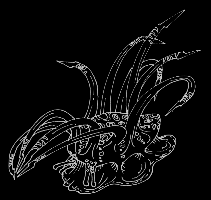 Hamilton writes: “If life has a purpose, they speculate, then it must be a journey to complete understanding.”
Hamilton writes: “If life has a purpose, they speculate, then it must be a journey to complete understanding.”
A Ly-cilph arrives at the edge of the Oort cloud surrounding Lalonde’s stellar system in 2610, after traveling through space, making numerous observations for billions of years. As is the custom, the being made an overview analysis of the system, focusing on the uninhabited regions first. It learns of the inner worlds first. Calcott, Gatley, Plewis and Coum. Having skipped Lalonde (the third planet from the star) for the moment, it researches and classifies the five gas giants in the system: Murora, Bullus, Achillea, Tol, and Puschk, the last with a “strange cryochemistry.” After 15 months, and having made brief note of the Edenist Habitat, Aethra, orbiting Murora, the Ly-cilph heads for Lalonde.
A Ly-cilph manifests itself to Father Horst in his church. He believes it to be some kind of demon spirit. It analyzes his thoughts, which Horst experiences as a rush of his thought processes “headlong through empty space.” Briefly, he loses the sense of time and place and experiences a complete emptiness that terrifies him. When he regains his senses, the Ly-cilph appears as a small ruby star above him. This sends the poor unstable priest rushing out into the jungle with wild abandon.
This particular Ly-cilph has categorized millions of species of lifeforms during its journeys through space. Comparatively few of these are capable of recognizing its presence, so it is naturally inquisitive about Father Horst and the other humans. It perceives humans as possessing “a great deal of potential for energistic perception development.” This, however, is encumbered with a reasoning mind that conflicts with such development. The Ly-cilph has no record of any species in the universe where this conflict is so sharply defined.
The Ly-cilph is present at the sacrifice of Powel Manani by Quinn. It detects a slight transfer of energy from Manani to Quinn. As Hamilton puts it: “This transference was extraordinarily rare in corporeal entities. And Quinn Dexter seemed to be aware of it at some fundamental level, he possessed an energistic sense far superior to that of the priest” (meaning Father Horst). The Ly-cilph inserts itself into this energy flow to learn more of it. It discovers that it is an “energistic vacuum.” It opens its perceptual abilities into the vacuum and discovers a chaotic assortment of independent entities. When it attempts to communicate with this assortment, the Ly-cilph itself is invaded and is forced to shut itself down, trapped in a gridlock with these “alien mentalities” until the infinitesimal chance that it is reanimated by its own kind in the future. This is the most basic description Hamilton offers us as to the workings of the reality dysfunction.
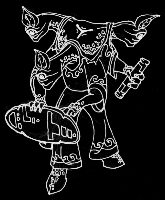 The Laymil -
The Laymil -
A spacefaring civilization mysteriously destroyed by some means whose remains form the Ruin Ring around Mirchusko. Their habitats were similar to those of Edenists. Bitek cylinders, but “fatter” than human designs. They used a rigid geometric architecture that was all flat planes and right angles. No curves had ever been discovered during research upon the Ring. From this on-going research it is determined that these beings were trisymmetric with three arms, legs, three short serpentine sensors for heads, and three sexes: female and two male types. Otherwise, they seemed to have behaved in a very human way biologically and technologically.
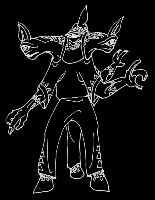 We learn more about the trisymmetric nature of the Laymil from Ione’s sensevised experience. Their three legs each possessed a double-jointed knee and a hoof at the end. Each of their three arms had hands with four triple-jointed fingers, and three heads rising in medusa fashion from the shoulders. Each had one eye and one bat-like ear. Each head also had a toothless mouth through which the creature breathed, smelled and vocalized. Laymils possessed a fourth mouth at the top of their “neck” between the three “heads” that had needle-type teeth with which the creatures fed.
We learn more about the trisymmetric nature of the Laymil from Ione’s sensevised experience. Their three legs each possessed a double-jointed knee and a hoof at the end. Each of their three arms had hands with four triple-jointed fingers, and three heads rising in medusa fashion from the shoulders. Each had one eye and one bat-like ear. Each head also had a toothless mouth through which the creature breathed, smelled and vocalized. Laymils possessed a fourth mouth at the top of their “neck” between the three “heads” that had needle-type teeth with which the creatures fed.
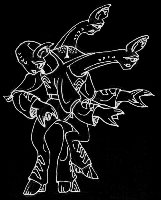 Research reveals that Laymil females have five reproductive cycles which are subject to artificial restraints in the form of pagan-like rituals. Thanks to the electronics stack that Joshua recovered from the Ruin Ring, the Laymil research project begins to unravel certain aspects the xenoc’s cultural attributes. As Hamilton has Ione put it: “They revered any living entity. And their psychology is almost incomprehensible to us; they could be both highly individual, and at the same time submerge themselves into a kind of mental homogeneity. Two almost completely different states of consciousness.” This is not to be confused with the Edenists affinity band, which allows an slowly fading core of identity to transfer into the personality habitat. For the Laymil, there seems to have literally be no difference from the personal and the collective consciousness.
Research reveals that Laymil females have five reproductive cycles which are subject to artificial restraints in the form of pagan-like rituals. Thanks to the electronics stack that Joshua recovered from the Ruin Ring, the Laymil research project begins to unravel certain aspects the xenoc’s cultural attributes. As Hamilton has Ione put it: “They revered any living entity. And their psychology is almost incomprehensible to us; they could be both highly individual, and at the same time submerge themselves into a kind of mental homogeneity. Two almost completely different states of consciousness.” This is not to be confused with the Edenists affinity band, which allows an slowly fading core of identity to transfer into the personality habitat. For the Laymil, there seems to have literally be no difference from the personal and the collective consciousness.
Further translation of the memory circuits reveals information about Laymil spaceships. They have three separate sections. Life support cabins in front, housed in four metallic ovoids. The mid-section contained five navigational heat-radiation tubes. The rear contained a single fusion tube for propulsion. The ships are believed to have been 80% organic. They apparently possessed no commercial cargo ships, having a culture based completely upon the exchange of technical templates and DNA between clans with no economic commerce.
More important, however, is the discovery that the Laymil home planet (Unimeron) once existed in the same star system as Tranquillity itself. The planet seems to have vanished without a trace. The researchers still believe the Laymil destroyed themselves because they encountered a strange transformation in their life-harmony gestalt across the entire planet. But how they managed to make any entire planet disappear without a trace just 2500 years later is a mystery.
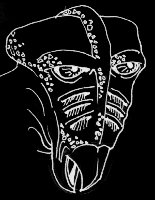 The Kiint-
The Kiint-
Massive, elephant-sized creatures that are highly intelligent. They are the most technological race in the Confederation, However, they don’t care for space travel, so they’ve never built ZZT spaceships. Kiints possess telepathic capability that can be accessed by Edenists on occasion, if the Kiint so chooses. They are highly inquisitive, natural seekers of knowledge. Physically, they possess a bright white hide that gives off a halo effect under certain lighting conditions. Their average body size is 9 meters long and 3 meters wide, supported by eight elephantine appendages. Head is about 2 meters long, a bony downward pointing triangle that resembles an ancient shield with a beak on the end.
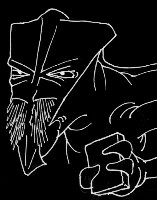 Perhaps their most distinctive characteristic is their "hands", which have tractamorphic muscles. These are capable of morphing in a number of ways to suit the needs of the Kiint. They can be human-like, hammer-like, tweezer-like, etc. They are a member of the Confederation and are more closely allied with humans than Tyragathas, the other primary xenoc race. They remain very mysterious, however. Naturally aloof, they reveal little about themselves, they are more interested in learning about others than revealing anything about themselves.
Perhaps their most distinctive characteristic is their "hands", which have tractamorphic muscles. These are capable of morphing in a number of ways to suit the needs of the Kiint. They can be human-like, hammer-like, tweezer-like, etc. They are a member of the Confederation and are more closely allied with humans than Tyragathas, the other primary xenoc race. They remain very mysterious, however. Naturally aloof, they reveal little about themselves, they are more interested in learning about others than revealing anything about themselves.
They discourage casual visits to their homeworld of Jobis. Their only reason for participating in the Confederation at all is to trade in information. They acquire data on almost any subject in exchange for technological data which was never revolutionary but always improved upon existing designs.
The Tyrathca –
Maintain a settlement on Lalonde to harvest berries from the rygar bush found there. They considered the berries a special treat when ground into a cold beverage or served as a sticky fudge. Normally, the Tyrathcas avoided contact with other races. They traditionally live in small settlements. Their houses are only used once and sealed up as a tomb when its in habitants die. They have a caste society divided into breeders, soldiers, vassals and other roles. The are faintly equine in appearance and about the size of a horse. They have no visible ears or nostrils, their mouth resembling a clam shell. Their two arms extend from behind the base of the neck, each with a nine finger circular hand. The breeder caste is the only fully sentient Tyrathca. They secret chemical instructions for activities via special teats into the brains of the vassal-caste who then would carry out whatever the instructions were. Tyrathca young are educated by the same process. They have no true religion, but in times of trouble (such as now) they call upon what they refer to as “The Sleeping God” to help them. Knowledge of this “God” has been handed down through the ages in an oral (chemical) tradition by the family of Sireth-AFL, whose earlier generations learned of on the Tyrathca flightship Tanjuntic-RI. This, in turn, was learned from another, unnamed and unknown, flightship that actually encountered the “God.” The Tyrathca are convinced this “God” will save them from the possessed humans and pray to an idol they construct in the god’s honor.
The Edenists:
An egalitarian society governed by the “consensus” formed out of their affinity link with one another. Edenism honors the captains of voidhawks particularly, however, because of their importance in commerce, trade, and defense. Since Edenists know that upon death there is a continuation as part of the personality habitat, then physical death no longer poses a problem for them, so they tend to be non-religious, have stable personalities, and invest their “spiritual” energy into their knowledge of quantum cosmology. They are al naturally geneered for the free fall of space flight. Many Edenists find Adamists difficult to get along with or to understand. Adamists tend to keep their thoughts and emotions to themselves, whereas Edenists more or less share everything through their affinity bands. Edenists prefer to be direct, honest and even blunt about things. Many Adamists find this abrasive.
Edenists have no psychological problems except for Serpents. The knowledge that they will continue after death as part of the personality habitat eliminates many psychoses with which Adamists have to deal.
With one exception (the planet Atlantis), Edenists live in bitek habits orbiting gas giant planets where they can utilize the enormous magnetospheres for power generation. To see a size comparsion of a typical Edenist Habitat with a Voidhawk and a human being click here.
The fundamental psychological principal of Edenism is that the sufferings and burdens of Edenists are mitigated throughout Edenist society through the affinity band.
Voidhawk Zygotes-
Embryos meant to become captains of voidhawks. Stored in zero-tau at the moment of conception of the fertilized ova. Once removed, they are implanted in a voidhawk’s egg for one year. The zygote is then removed and allowed to develop as would any human child. Its education is the responsibility of the habitat in which it was spawned. Much of the learning takes place as the child sleeps. The child gains affinity communication capability early on and is able to relate to its corresponding voidhawk, even though the two are not physically together. At 15, each child begins to learn how to captain a their voidhawk. The voidhawks join in on their learning sessions with the habitat personality regarding the intricacies of spaceflight. At 18, the Edenist (and voidhawk) are ready for first flight.
The Adamists -
“Traditional” humans who use fusion-driven starships and specially geneered blackhawks to travel through space. They oppose all use of pure bitek. Instead, they rely solely on advances in fusion technology and, particularly, in nanotechnology to advance their lives and civilizations. They hold traditional religious values and beliefs. How they continue on after death is one of the major subjects explored in the Trilogy. Hamilton tells us their “DNA was geneered but not expanded” as was that of the Edenists. Handle free fall in spaceflight by use of nanonics. It is an interesting fact that one and a half million Adamists choose to become Edenists every year throughout the Confederation.
Vennels -
Monkey-like reptilian animals that inhabit Lalonde.
Sayces -
Aggressive catlike creatures with black scales and deeply intelligent. Has a wedged-shaped head and razor sharp teeth. They are featured in Durringham much like “cock-fights” with bets placed on each match, always a vicious duel to the death. In this manner, Quinn transfers the stolen credits of a Jovian Bank credit disk into Lalonde francs for local spending. In seven fights he manages to turn 800 fuseodollars into 2500 Lalonde francs.
Danderil -
Galzelle-like creature inhabiting the jungle regions around Aberdale.
Kestrels -
Native birds of Lalonde. Highly aggressive and predatory. Laton affinity bonds with one and uses it as a scout to keep any eye on things.
Sailu -
Extremely rare small black and white furry animal found only on Oshanko. Used exclusively as pets by the Japanese imperial family there. Extremely cuddly, soft, and gentle creatures. They are bipedal in shape, without any elbows of knees, their limbs bending along their entire length. They have several sexes and prefer a diet of strawberries and lettuce. Joshua steals one for Ione while he is away on an extended trading mission. Ione, the only person in the Confederation outside Oshanko with a Sailu, is naturally impressed. She decided to call the creature “Augustine”, a noble name.
Hax –
Wolf-like creatures that inhabit Norfolk. Farmers hunt them for sport in the winter.
Kroclion –
A powerful carnivorous animal on Lalonde that preys on anything, even sayces. Nearly four meters long and weighing half a ton, it has a yellowish hide that blended in well with the savanna grass. It has the head of a shark, with plenty of sharp teeth and small eyes.
Ghosts –
Beings somehow trapped between human reality and being fully in the beyond. They are incapable of escaping their limbo and are completely dejected in their hopeless state. Quinn discovers them on the asteroid Jesup.